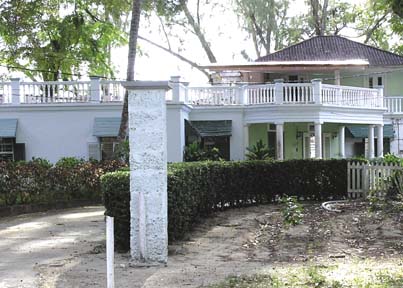Making Waves (Page 2)
The Bellairs Research Institute

Tucked in along a stretch of upscale resorts on prime Barbadian real estate is a package of land that in 1954 was generously donated to McGill for a scientific research station. "Sandacres," as the property was originally known, was owned by Commander Carlyon Bellairs, a member of both the British Royal Navy and British Parliament during the Churchill years. After his career, he bought the estate and lived there with his wife.
Wishing to develop closer ties with Canada, the Commander wrote a letter to Governor-General Vincent Massey, then Chancellor of the University of Toronto, stating that after his death, he hoped his estate could be used by a Canadian university to promote British-Canadian relations and to benefit the island of Barbados. Massey didn't take the offer seriously, and according to McGill historian Stanley Frost, LLD'90, passed it along to McGill Principal F. Cyril James with a "semi-humorous remark that this kind of thing was likely to be of more interest to McGill than to Toronto." Indeed it was, and James quickly set off to visit the Commander. The Principal recounted his stay in a University address:
"[I] spent several interesting days at Sandacres discussing with the Commander his dreams. He was convinced that scientific research would strengthen the economy of Barbados and enhance the welfare of its people. He wanted McGill University to undertake the task of carrying out such research, and he would like to leave his estate to McGill as trustee for the discharge of that responsibility."
McGill accepted the responsibility, and later that year a young scientist, Dr. John Lewis, and his wife took up residency at Sandacres with the Commander. A laboratory and aquarium were built, and Dr. Lewis began research on the life history of sea urchins.
The Commander died in 1955 and 50 years later, McGill is still upholding his wishes, hosting researchers from Canada and other countries. Bruce Downey, PhD'81, the Institute's current director, says that "Barbados is an ideal living laboratory facilitating studies in a variety of disciplines." While, in the early years, most investigations were restricted to marine biology, later studies have included climatology, geomorphology and even computer science.
Bellairs has also become a reputable teaching facility. Each year, McGill undergraduates and faculty from engineering or environmental sciences spend a 13-week semester gaining hands-on knowledge about water-related issues. "It's part of our desire to get McGill students out into the world and globalize them through experience," says Dean of Science Alan Shaver. "To my knowledge, Bellairs is Canada's only university-owned research and teaching institute in the tropics."
Recently, the focus at Bellairs has shifted to conservation issues. There has been a massive decline of corals in the Caribbean over the last 30 years and the reefs in front of Commander Bellairs's Sandacres no longer host the pristine, boundless marine life that he once knew. Still, he would be satisfied to know that significant advances in marine science and conservation have been achieved at McGill's Caribbean scientific getaway.
For more information, see www.mcgill.ca/bellairs.


